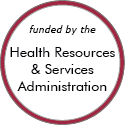Rural Response to the Opioid Crisis – Models and Innovations
These stories feature model programs and successful rural projects that can serve as a source of ideas and provide lessons others have learned. Some of the projects or programs may no longer be active. Read about the criteria and evidence-base for programs included.
Evidence-Based Examples
Project ECHO® – Extension for Community Healthcare Outcomes
Updated/reviewed February 2024
- Need: Increase medical management knowledge for New Mexico primary care providers in order to provide care for the thousands of rural patients with hepatitis C, a chronic, complex condition that has high personal and public health costs when left untreated.
- Intervention: Project leveraging an audiovisual platform to accomplish "moving knowledge, not patients" that used a "knowledge network learning loop" of disease-specific consultants and rural healthcare teams learning from each other and learning by providing direct patient care.
- Results: In 18 months, the urban specialist appointment wait list decreased from 8 months to 2 weeks due to Hepatitis C patients receiving care from the project's participating primary care providers. Improved disease outcomes were demonstrated along with cost savings, including those associated with travel. The project model, now known as Project ECHO® – Extension for Community Healthcare Outcomes — has evolved into a telementoring model used world-wide.
Effective Examples
Vermont Hub-and-Spoke Model of Care for Opioid Use Disorder
Updated/reviewed November 2025
- Need: In the early 2010s, needed increase access to medication treatment for opioid use disorder in rural Vermont.
- Intervention: 2012-2016 implementation of a statewide hub-and-spoke treatment access system.
- Results: The original system's increased treatment capacity and care coordination successes now are a permanent system of integrated care overseen by the Vermont state health department and Vermont Blueprint for Health.
Project Lazarus
Updated/reviewed May 2024
- Need: To reduce overdose-related deaths among prescription opioid users in rural Wilkes County, North Carolina.
- Intervention: Education and tools are provided for prescribers, patients and community members to lessen drug supply and demand, and to reduce harm in prescription opioid use.
- Results: Opioid overdose death rates have decreased in Wilkes County.
Other Project Examples
One Health Recovery Doulas

Updated/reviewed November 2025
- Need: To support pregnant and parenting women with a history of substance use, mental health, or co-occurring disorders in rural areas of Montana.
- Intervention: One Health, a consortium of Federally Qualified Health Centers (FQHCs), developed a team of "recovery doulas" – individuals who are dual-certified as doulas and peer-support specialists. The One Health recovery doula program offers group and individual services to women and their partners from pregnancy through the first years of parenthood.
- Results: A team of four recovery doulas (or doulas-in-training) employed by One Health offer services in 8 rural eastern Montana counties. One Health has also successfully trained and certified 35 Peer Recovery Doulas statewide through their Peer Recovery Doula certification curriculum.
Recovery Friendly Workplaces in Marinette County
Added November 2024
- Need: To reduce barriers to employment for people in substance use recovery in Marinette County, Wisconsin.
- Intervention: An initiative in which community members in recovery train local employers in recovery friendly workplace guidelines and provide recovery coaching to employees.
- Results: One business in Marinette County has been fully trained, and more than 50 people in recovery have been referred to the Wisconsin Department of Workforce Development's Worker Connection Program in the program's first year.
The Pennsylvania Medications for Opioid Use Disorder (PA MOUD) Technical Assistance and Quality Improvement Expansion Project
Added June 2024
- Need: To expand access to medications for opioid use disorder (MOUD) across the state of Pennsylvania.
- Intervention: An initiative formed to provide technical assistance aimed at improving MOUD treatment capacity and quality at healthcare sites across urban and rural Pennsylvania.
- Results: In 2023, 108 providers engaged with the program, treating a total of 5,185 individuals with MOUD. Currently, the program engages partners in 20 Pennsylvania counties – serving rural populations in Crawford, Schuylkill, Susquehanna, Butler, and Cambria counties.
Richmond Substance Use and Mental Health Mobile Integrated Health Program
Added November 2023
- Need: To reduce the number of overdose deaths in Richmond, Indiana and connect people in need of mental health treatment to community resources.
- Intervention: A mobile integrated healthcare (MIH) program that connects social workers with people who have just experienced a mental health crisis or overdose.
- Results: More than 320 people have been referred to Richmond's MIH programs since June 2022.
MIST: Mothers and Infants Sober Together

Updated/reviewed May 2023
- Need: To address the needs of pregnant women who are using substances and infants born into drug-positive families.
- Intervention: The Mothers and Infants Sober Together (MIST) program assisted mothers who used substances get treatment and provide a safe, drug-free home for themselves and their newborn.
- Results: MIST has helped mothers find treatment and education and has helped children grow up in safe and healthy homes.
Addiction Recovery Mobile Outreach Team (ARMOT)

Updated/reviewed January 2023
- Need: To reduce the number of overdoses and overdose-related deaths from opioids in rural Pennsylvania.
- Intervention: ARMOT provides 1) case management and recovery support services to individuals with substance use disorders and 2) education and support to rural hospital staff, patients, and their loved ones.
- Results: Since 2015, ARMOT has received over 2,956 referrals.
ASPIN's Certified Recovery Specialist Program


Updated/reviewed September 2022
- Need: Improved approach in addressing the behavioral health and primary care disparities of Indiana's rural counties.
- Intervention: A network was established that trained community health workers (CHWs) to be certified health insurance enrollment navigators and provide mental health services.
- Results: This year, ASPIN trained 230 CHWs, cross-trained 70 behavioral health case managers as CHWs, and 35 individuals in the Indiana Navigator Pre-certification Education.
Last Reviewed: 12/30/2020

